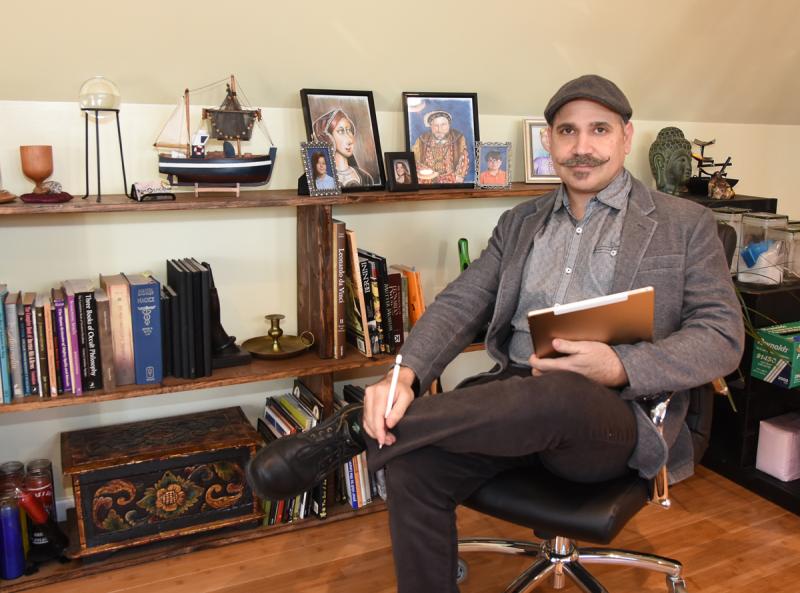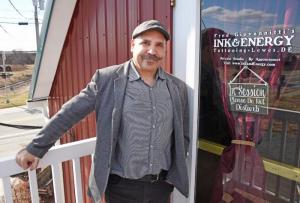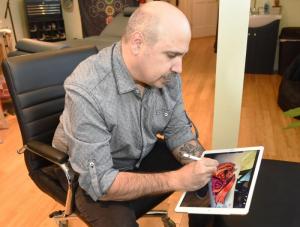Fred Giovannitti: Tattoo artist, inventor
Fred Giovannitti doesn't fit the mold of a tattoo artist, and he never has. "I was never interested in tattooing," he said. "It was never a thing that I thought I'd want to get into."
An artist from a young age, Giovannitti worked up tattoo designs for friends. After seeing the result, he knew the best person to bring his designs to life was himself. "My friend was excited about it, but I wasn't," he said. "The shading was all wrong and the amount of detail was unimpressive."
At the time, Giovannitti was working in graphic design and textile design for Vision Streetwear and Life's A Beach, which eventually became No Fear. The art of tattooing came to him naturally, and it didn't take long for him to master it. He became a professional in 1993.
"I still had no intention of getting into this lifestyle," he said. "Then one thing led to another, and the immediate financial gratification of getting paid just to draw something on somebody convinced me to put everything else on the back burner. Here I am, still doing it today."
Giovannitti had as many as five studios when he lived in Las Vegas. But after relocating to Oregon and then to Milton, he's scaled it back to a private, appointment-only studio in Nassau, above Old World Breads.
The tattoo experience with Giovannitti is not only about the ink. For him, it's much more. "I have to meet somebody, talk to them and get in their head," he said. "I have to learn about them because we're going to be co-parents of a baby here, a work of art, and we have to be on the same page."
The first session is a consultation. Giovannitti calls it a combination of a speed date and a spiritual interview. "Usually people will come in with a vague idea of what they want," he said. "The idea may be so vague that oftentimes it turns out to be not even what they wanted. I suppose the initial consultation is to help extract bits and pieces of information they may have overlooked themselves."
Throughout the consultation, Giovannitti talks to his clients about their lives – family, friends, hobbies, what motivates them. All the while, he's sketching and trying to find the perfect piece of art to embody the client. "There has to be a story behind it," he said. "I'm not just going to give you a Garfield because Garfield is funny. There has to be a story and experience behind it."
If the tattoo is in an area that's not too sensitive, Giovannitti likes to keep the conversation going while he works on the piece.
"I get a chance to dig deeper and learn more about them and about the piece we're working on," he said. "I want to love the piece too." The experience is often therapeutic for clients, he said. It gives them an opportunity to recall and process things they've suppressed or forgotten.
"I've had clients crying because they remembered things we're putting into the piece that are meaningful to them," he said. "When they leave, they have this feeling of being lighter. And the tattoo just shines with all the love that was in that session, all that energy that was flowing."
It was through one of these sessions that Giovannitti was inspired to do his part to save the world. "I was working on a client, and he didn't seem very happy. It seemed like he had everything he could need, but I could tell this guy was missing something," he said. "Eventually, I worked into the conversation, 'if you could be doing anything other than what you're doing right now, what would you be doing?'"
That's when his client told him about the Pacific trash vortex, an area the size of Texas in the North Pacific Ocean that has collected and trapped massive amounts of plastics. His client wished he could do something about it. Between sessions, the gears started turning in Giovannitti's head. He sketched up a contraption that could collect plastics and eventually clean the ocean. At the next session, Giovannitti showed it to his client, and it blew his mind.
The inspiration for the idea originated during a trip he and his family took to Laguna Beach, Calif. Walking back from the beach, he saw an air conditioning unit covered in pine needles. The unit was sucking them in but they could not penetrate the interior. He applied the same concept to water.
The client was curious how it would work, so Giovannitti went to the local hardware store, bought supplies and tested a rudimentary version of his invention – a marine particle skimmer. "I put it in my bathtub and put confetti all around it," he said. "A current fan took water from inside a box and thrust it out. There was no other way for water to come in than through vents. I came back about an hour later and the whole bathtub was free of confetti and it was all stuck to the outside of the filters."
Giovannitti had the skimmer patented and was working to develop it further when the Deepwater Horizon oil spill disaster occurred. He said people kept asking him if his concept could be applied to oil cleanup. After some tinkering, Giovannitti came up with something he believed could work – the emergency extraction line. Following a concept similar to his first design, he said, the amount of oil the invention could pick up was directly proportional to the strength of the pipe.
Giovannitti and his team put it to the test at the Wendy Schmidt Oil Cleanup X Challenge. The goal of the challenge is to develop rapidly deployable, highly efficient methods for oil cleanup. The first-place prize is $1 million. During testing, the emergency extraction line was working at 97 percent efficiency. The best skimmers out there at the time worked at 45 to 50 percent efficiency, he said.
Due to cost restrictions, Giovannitti and his team were forced to use thinner steel than they had planned. That resulted in problems when they got to the competition trials. "We had already tested it in flat water and wavy water," he said. "When we got to the test, it was so beat up that during the wavy part it started to come apart."
Despite damage, the emergency extraction line was still 70 percent efficient, much higher than most oil-cleanup technology. It still wasn't enough to bring home the top prize. Both the emergency extraction line and the marine particle skimmer are patented, and Giovannitti is seeking more funding for further development.
In the meantime, Giovannitti has turned his attention to other inventions that help save the planet. He is currently developing a vending machine where customers can convert their used plastic shopping bags into useful household items, such as drywall anchors or children's toys. His latest invention is patent pending.
Giovannitti traces his artistic and innovative mind back to his childhood. His father was in the Navy, so his family traveled often. He was born in Virginia, but soon moved to Japan. During his childhood, the family lived in Cyprus, Turkey, Greece, Italy and Las Vegas, which became their home base when back home.
"I feel like doing that at a young age forced me to learn how to make friends quick," he said. "And on the flip side, it also forced me to learn how to say goodbye quick." It was about seventh grade when he realized he had an artistic talent. He said he started drawing sports cars and hot rods with neighborhood friends when he noticed his drawings were just a little better. He then started reproducing Iron Maiden album covers for friends.
"I never thought I'd pursue art," he said. "For some reason, it was told to me often by my parents or authority figures to not pursue art because the only rich artists are dead artists. I suppose the anti-authoritarian in me fought back against that and wanted to prove them all wrong."
As the parent of two children, he didn't want to shut his children off from the arts. He's encouraged them and has even collaborated with them for a unique art project. Though based in Delaware, Giovannitti still makes monthly trips out to Las Vegas for work. Prior to leaving, he often had his kids sketch a drawing from a photograph in a magazine or online, such as famous paintings of Henry the VIII and one of his wives, Anne Boleyn, or photos of a whale or leopard. To pass the time while traveling, Giovannitti would color in the drawing, adding his own artistic flair to the piece.
The result was a collaborative effort that he said brought the family closer. He posted them online, often with a video showing the progression of the project. They went viral. "Three years in a row they went internationally viral," he said. "I would be getting requests from Australia, France, China, Germany. They'd ask for interviews and even want to talk to the kids. "The kids have no idea how internationally famous they are for their artwork."
And despite his voluminous irons in the fire, Giovannitti likes that he sits a little bit in the shadows. "I don't want everyone to know me," he said. "If anything, I want to know everybody."
The highlight of his job, he said, is the conversations he has with clients, learning about them and their lives. "If you think about all your experiences that have led up to today, all those near misses with death and your adventures with this and that, you have a whole lifetime of stories to tell," he said. "I get to do that with each person. Everyone is like a universe of stories."
To learn more about Giovannitti, go to www.inkandenergy.com.
Nick Roth is the news editor. He has been with the Cape Gazette since 2012, previously covering town beats in Milton and Lewes. In addition to serving on the editorial board and handling page layout, Nick is responsible for the weekly Delaware History in Photographs feature and enjoys writing stories about the Cape Region’s history. Prior to the Cape Gazette, Nick worked for the Delmarva Media Group, including the Delaware Wave, Delaware Coast Press and Salisbury Daily Times. He also contributed to The News Journal. Originally from Boyertown, Pa., Nick attended Shippensburg University in central Pennsylvania, graduating in 2007 with a bachelor’s degree in journalism. He’s won several MDDC awards during his career for both writing and photography. In his free time, he enjoys golfing, going to the beach with his family and cheering for Philadelphia sports teams.
























































